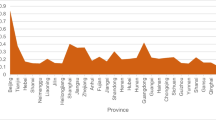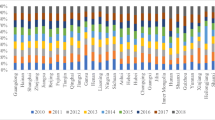Abstract
This paper proposes a green finance index that may help policymakers and investors take more favorable actions based on the development of green finance. After analysis and organization of the development process of green finance and related green finance and index concepts, this paper uses the improved fuzzy comprehensive evaluation method to construct a measurement model suitable for measuring the development level of green finance based on the principle of fuzzy mathematics. The index weight adopts the entropy method and improved Analytic Hierarchy Process (AHP) joint determination. At the same time, using the relevant statistical indicators of China's green credit from 2011 to 2019, and using the constructed model, the level of China's green finance development during this period was evaluated. Finally, the obtained data and classical gray model methods were used to predict China's green development level from 2020 to 2024. The research results show that: This model is a good measure of the level of development of green finance, and China's green finance index has generally shown a rapid growth trend over the past nine years, with the fastest growth rate between 2013 and 2014. From the perspective of the weight of each index affecting the green financial index, the weight of new energy, green transportation projects and new energy vehicles ranked in the top three, and the impact of these three indexes on China's green financial index is significant. In the future, China's green financial development level will continue to improve.



Similar content being viewed by others
References
Akin T, Iqbal Z, Mirakhor A (2016) The composite risk-sharing finance index: implications for Islamic finance. Rev Financ Econ 31:18–25
Bidding Task Force of the People’s Bank of China Nanchang Center Sub-branch (2018) Research on evaluation and statistical supervision of green finance development. Finan Econ 11:29–35
Bu T-T, Zhang J-H, Wu X, Liu W-X (2013) Black start scheme evaluation of power system based on entropy weight method and improved AHP. Modern Electr 30(5):36–40
Chen N-W, Huang H-H, Lin C-H (2018) Equator principles and bank liquidity. Int Rev Econ Finance 55:185–202
China Banking Regulatory Commission,WWF, PWC (2014) The Sustainable Performance of Chinese Banking and International Financial Institutions Comparative Study
China Banking Regulatory Commission (2014) Key Evaluation Indicators of Green Credit Implementation, http://www.cbrc.gov.cn/chinese/home/docDOC_ReadView/FC5E38D62BE54E3D836E441D6FC2442F.html, Accessed 19 November 2019
China Banking and Insurance Regulatory Commission (2018) Disclosure of green credit statistical information, http://www.cbirc.gov.cn/cn/view/pages/ItemDetail.html?docId=171047, Accessed 20 October 2020
China Banking and Insurance Regulatory Commission (2018) Deepen information disclosure and promote sustainable and healthy development of green credit, http://www.cbirc.gov.cn/cn/view/pages/ItemDetail.html?docId=171282&itemId=915&generaltype=0, Accessed 20 October 2020
China Banking and Insurance Regulatory Commission (2018) Summary of green credit statistics of 21 major domestic banks, http://www.cbirc.gov.cn/cn/view/pages/ItemDetail.html?docId=171047, Accessed 20 October 2020
China Banking Association (2020) 2019 China Banking Industry Social Responsibility Report, https://www.china-cba.net/Index/show/catid/14/id/36020.html, Accessed 20 October 2020
Deng X (2012) Review of green finance research. J Zhong Univ Econ Law 6:67–71
Deng X, Li J-M, Jian H, Chen J-Y, Zhao J-F (2012) Analytic hierarchy process weight calculation method analysis and Application Research. Pract Understand Math 7:93–100
Green Finance Committee of CFA (2019) Central Asian countries jointly discuss the construction of green financial system, http://www.greenfinance.org.cn/displaynews.php?id=2629, Accessed 7 November 2019
Green Finance Research Group (2016) G20-2016 Comprehensive Report on Green Finance, International Financial Organization (IFC). Hangzhou, China
Guo W-Q, An Y-L, Liu S-X (2011) Study on the driving forces of rocky desertification in guizhou province based on variation coefficient method. Meteorol Environ Res 2(2):76–79
He H, Chen M-Y (2004) Defect and improvement of GM (1,1) model prediction formula. J Wuhan Univ Sci Technol 26(7):81–83
Hof AF, Elzen MGJ, Beltran AM (2012) Predictability, equitability and adequacy of post-2012 international climate financing proposals. Environ Sci Policy 14(6):615–627
Hu Q-F, Fan L, Dong Z-J, Zhou H-M, Yang Y, Li Y-J (2014) Application of improved AHP based on fuzzy comprehensive evaluation in landslide risk assessment. J Yangtze River Acad Sci 31(5):29–33
Huang G-Q, Wang M-X, Wang G-L (2012) Research on the improvement of entropy method in efficiency evaluation. Comput Eng Aappl 28:245–248
Hayat F, Daniel M, Pirzada S, AliKhan A (2018) The validation of Granger causality through formulation and use of finance-growth-energy indexes. Renew Sustain Energy Rev 81(2):1859–1867
Jia J-P, He X-Q, Jin Y (2009) Statistics, 4th edn, China Renmin University Press, pp 406.
Zeng X-W (2014) Measurement analysis of China's green finance development. China Yanan Cadre Coll J 6: 112–121.
Jin J-L, Yang X-H, Ding J (2001) An improved scheme of standard genetic algorithm accelerated genetic algorithm. Syst Eng Theory Pract 21(4):8–13
Jin J-L, Wei Y-M, Ding J (2004) Fuzzy evaluation model based on Improved AHP. J Hydraulic Eng 3:65–70
Li C-W, Cai Y-W, Jiang J-J (2018) Construction and thinking of green finance development index. Gansu Finance 9:31–35
Liu S-F, Lin Y (2006) Grey information: theory and practical applications. Springer, London
Mohsin M, Taghizadeh-Hesary F, Panthamit N, Anwar S, Abbas Q, Vo X V (2020) Developing Low Carbon Finance Index: Evidence From Developed and Developing Economies, Finance Research Letters, Article 101520
Peng H, Feng T, Zhou C-B (2018) International experiences in the development of green finance. Am J Indust Bus Manag 8(2):385–392
Research Group of Shizuishan City Sub-branch, People’s Bank of China (2018) Development status of green finance and construction of evaluation system. Western Finance 5:78–82
Research Group of the People’s Bank of China Wuxi Downtown Branch (2019) Research on comprehensive evaluation of sustainable development of green finance in China. Financ Aspect 2:44–50
Street P, Monaghan PE (2001) Assessing the sustainability of bank service channels: the case of the Co-operative Bank, Sustainable Banking: The Greening of Finance. Sheffield
Tian J, Zhang P-Z, Wang K (2004) Research on expert opinion integration model based on Delphi method. Theory Pract Syst Eng 1:57–69
Xu J-G, Li H-H, Wu J (2005) Comparison of economic development level of different regions in China—fuzzy comprehensive evaluation model based on Improved AHP. Chin Manag Sci 13:595–599
Yang P, Ma J (2017) Comparison of green finance development models between China and Britain. China Finance 22:62–64
Zheng C-H, Jiao L-C, Li Y-Z (2008) Support vector classifier based on principal component analysis. J Syst Eng Electron 1:184–190
Zhang C-H, Xie M-Z, “Greening China’s Financial System” Task Force of the Development Research Center of the State Council (2016) The logic and framework of developing China’s green finance. Financial Forum 2:17–28
Author information
Authors and Affiliations
Corresponding author
Additional information
Handling Editor: Luiz Duczmal.
Appendices
Appendix A
The 21 major banking institutions include: China Development Bank, Export Import Bank of China, Agricultural Development Bank of China, Industrial and Commercial Bank of China, Agricultural Bank of China, Bank of China, China Construction Bank, Bank of Communications, China CITIC Bank, China Everbright Bank, Huaxia Bank, Guangdong Development Bank, Ping An Bank, China Merchants Bank, Pudong Development Bank, Industrial Bank, China Minsheng Bank, Evergrowing bank, China Zheshang Bank, China Bohai Bank and Post Savings Bank of China.
Appendix B
With the help of MATLAB software, the judgment matrix is processed to make the calculation easier.
Start the MATLAB software and input in the command window:
clc.
clear all.

%%Consistency test and weight vector calculation.
[n,n] = size(B);
[v,d] = eig(B);
r = d(1,1);
CI = (r-n)/(n-1);
RI = [0 0 0.52 0.89 1.12 1.24 1.36 1.41 1.46 1.49 1.52 1.54 1.56 1.58 1.59];
CR = CI/RI(n);
if CR < 0.1
CR_Result = 'Pass';
else.
CR_result = 'Fail';
end.
%%Weight vector calculation.
w = v(:,1)/sum(v(:,1));
w = w';
%%Result output.
disp('Calculation report of weight vector of the judgment matrix:');
disp(['Consistency indicators:',num2str(CI)]);
disp(['Consistency ratio:',num2str(CR)]);
disp(['Consistency test results:',CR_Result]);
disp(['Eigenvalues:',num2str(r)]);
disp(['Weight vector:',num2str(w)]);
Output results:
Calculation report of weight vector of the judgment matrix:
Consistency index: 0.0074337.
Consistency ratio: 0.0046753.
Consistency test result: passed.
Characteristic value: 15.1041.
Weight vector: 0.066149 0.069312 0.029018 0.10879 0.065566 0.053291 0.030963 0.059657 0.12215 0.043634 0.048855 0.071576 0.019772 0.056393 0.15487.
That is to say, the weight \(W_{A}\) of the improved AHP is
Appendix C
Also use MATLAB software for prediction.
Start the MATLAB software and input in the command window:
X = [2011,2012,2013,2014,2015,2016,2017,2018,2019,2020,2021,2022,2023,2024];
Y = [2011,2012,2013,2014,2015,2016,2017,2018,2019];
B = [2838.007872,3306.99793,3694.050601,4664.444747,5591.202845,6239.958816,7163.469794,8484.417873,9908.6653];
A = [2838.007872,3349.710125,3909.546787,4562.948884,5325.55399,6215.613213,7254.427922,8466.859612,9881.924868,11,533.48981,13,461.08062,15,710.82945,18,336.57853,21,401.16876];
plot(Y,B,'-*b');
hold on.
plot(X,A,'-or');
legend('real','prediction');
xlabel('Time(y)');ylabel('Index');

Rights and permissions
About this article
Cite this article
Wang, X., Zhao, H. & Bi, K. The measurement of green finance index and the development forecast of green finance in China. Environ Ecol Stat 28, 263–285 (2021). https://doi.org/10.1007/s10651-021-00483-7
Received:
Revised:
Accepted:
Published:
Issue Date:
DOI: https://doi.org/10.1007/s10651-021-00483-7




